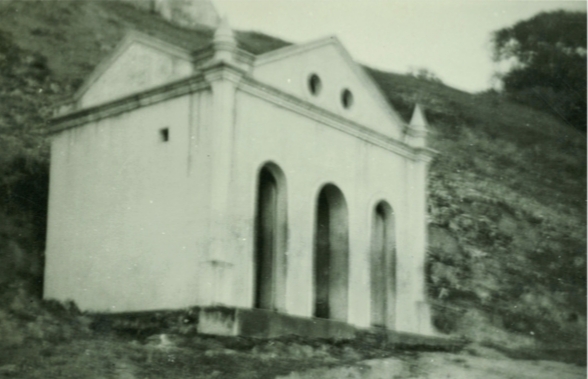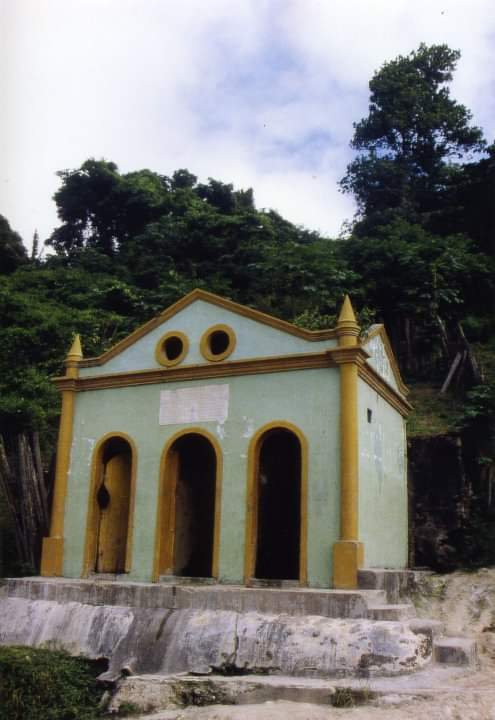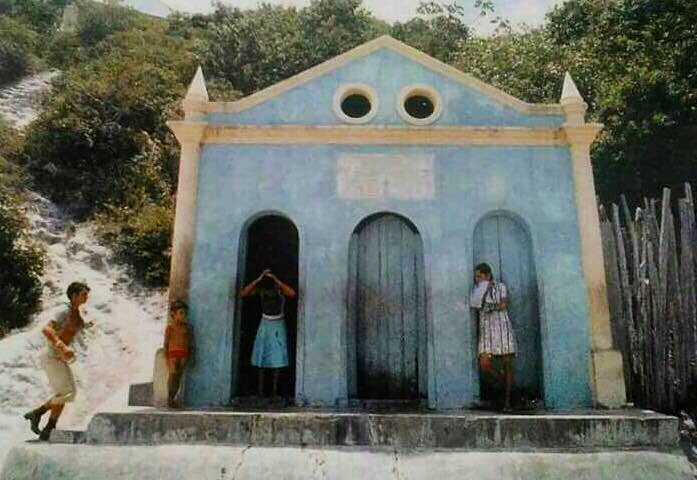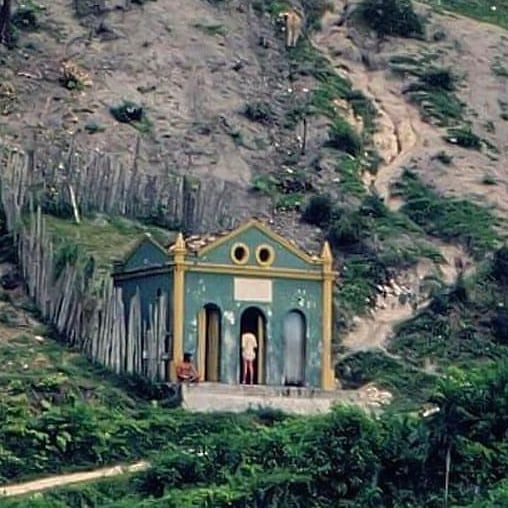"THE FOUNTAIN OF NOSSA SENHORA D'AJUDA"
One of the major elements linked to local religiosity is the Fountain of Our Lady of Ajuda. According to the religious tradition, it was during the construction of the Church of Ajuda that the fountain came into being. The first reports about it date back to the early 1550s and were made by Jesuit missionaries, who were responsible for building the church.
One of the oldest mentions of the fountain was made by Father Antônio Pires, in a letter written on 2 August 1551. He reported: "It is said all along the coast that a fountain, which was opened after the chapel was founded, gives health to the sick people." In 1555, Ambrósio Pires, also a Jesuit missionary, stated that the fountain was created due to the devotion of Father Manoel de Nóbrega, who wanted water for the construction of the church. Antônio Franco, another Jesuit, who wrote more than a century after the church was built, presented a similar version, but with an additional element: a conflict between the missionaries and a Portuguese settler. Accordingtohisaccount:
"(...) I would like to tell you about a great favor from God, which was obtained from heaven in the residence of Porto Seguro, in which Father Nobrega's faith played a large part. When our Father Francisco Pires and others were in Porto Seguro, they built a chapel of Our Lady of Ajuda on a hill. Water was very far from it, both for work and for drinking. They had to go down into the valley through the lands of a resident, who had a passion for it, saying that it devastated his farms. For this reason, he lodged complaints against the work and against our people.
The servants of God were distressed by their labour and by the unrest of man. They begged our Lady to help them. Father Nobrega was there. He encouraged them, telling them to have faith and he went to say Mass in the chapel, which was still unfinished. In the middle of the sacrifice, they heard water bubbling up from under the altar, and from there, under the earth, it came out near a tree close to the chapel (...)".
The information about its emergence was not very precise, which is why many versions of the event have arisen over time, although certain elements are common among them. The Jesuits are always linked to the Fountain, its waters are always considered miraculous and it itself is said to have arisen from a miracle. For centuries, the supposedly miraculous waters of the Fountain have been a central element of the devotion surrounding the Lady of Ajuda and, even today, many pilgrims who visit Arraiald'Ajuda every yearbathe in it, drink its water and take some of it back with them to their places of origin.
For a long time, the Fountain of Ajuda was the main source of water for the residents of Arraial, which emphasises its importance beyond religious matters. Between 1929 and 1930, members of the Brotherhood of Our Lady of Ajuda built the structure that houses the fountain. The building has undergone several renovations over time and remains one of the great symbols of Arraiald'Ajuda.
Bibliography
LETTER. Antônio Pires. Pernambuco, 2nd August 1551. In: LEITE, Serafim S. I. Letters from the first Jesuits in Brazil. Volume II (1553-1558). São Paulo: Commission of the IV Centenary of the City of São Paulo, 1954, p. 75-84.
LETTER. Ambrósio Pires. Salvador, 12thJune 1555. In: LEITE, Serafim S. I. Letters from the first Jesuits in Brazil. Volume II (1553-1558). São Paulo: Commission of the IV Centenary of the City of São Paulo, 1954, p. 254-258.
FRANCO, Francisco. Of how he was the cause of great increases in Christianity: how through his prayers the Governor had great victories. House of a miraculous fountain. And other things of great service ofGod through this servant of his. In: NÓBREGA, Manoel de. LettersfromBrazil (1549-1560). Rio de Janeiro: Industrial GraphicsWorkshop, 1931, p. 40-45.(1549-1560). Rio de Janeiro: Oficina Industrial Gráfica, 1931, p. 40-45.
One of the major elements linked to local religiosity is the Fountain of Our Lady of Ajuda. According to the religious tradition, it was during the construction of the Church of Ajuda that the fountain came into being. The first reports about it date back to the early 1550s and were made by Jesuit missionaries, who were responsible for building the church.
One of the oldest mentions of the fountain was made by Father Antônio Pires, in a letter written on 2 August 1551. He reported: "It is said all along the coast that a fountain, which was opened after the chapel was founded, gives health to the sick people." In 1555, Ambrósio Pires, also a Jesuit missionary, stated that the fountain was created due to the devotion of Father Manoel de Nóbrega, who wanted water for the construction of the church. Antônio Franco, another Jesuit, who wrote more than a century after the church was built, presented a similar version, but with an additional element: a conflict between the missionaries and a Portuguese settler. Accordingtohisaccount:
"(...) I would like to tell you about a great favor from God, which was obtained from heaven in the residence of Porto Seguro, in which Father Nobrega's faith played a large part. When our Father Francisco Pires and others were in Porto Seguro, they built a chapel of Our Lady of Ajuda on a hill. Water was very far from it, both for work and for drinking. They had to go down into the valley through the lands of a resident, who had a passion for it, saying that it devastated his farms. For this reason, he lodged complaints against the work and against our people.
The servants of God were distressed by their labour and by the unrest of man. They begged our Lady to help them. Father Nobrega was there. He encouraged them, telling them to have faith and he went to say Mass in the chapel, which was still unfinished. In the middle of the sacrifice, they heard water bubbling up from under the altar, and from there, under the earth, it came out near a tree close to the chapel (...)".
The information about its emergence was not very precise, which is why many versions of the event have arisen over time, although certain elements are common among them. The Jesuits are always linked to the Fountain, its waters are always considered miraculous and it itself is said to have arisen from a miracle. For centuries, the supposedly miraculous waters of the Fountain have been a central element of the devotion surrounding the Lady of Ajuda and, even today, many pilgrims who visit Arraiald'Ajuda every yearbathe in it, drink its water and take some of it back with them to their places of origin.
For a long time, the Fountain of Ajuda was the main source of water for the residents of Arraial, which emphasises its importance beyond religious matters. Between 1929 and 1930, members of the Brotherhood of Our Lady of Ajuda built the structure that houses the fountain. The building has undergone several renovations over time and remains one of the great symbols of Arraiald'Ajuda.
Bibliography
LETTER. Antônio Pires. Pernambuco, 2nd August 1551. In: LEITE, Serafim S. I. Letters from the first Jesuits in Brazil. Volume II (1553-1558). São Paulo: Commission of the IV Centenary of the City of São Paulo, 1954, p. 75-84.
LETTER. Ambrósio Pires. Salvador, 12thJune 1555. In: LEITE, Serafim S. I. Letters from the first Jesuits in Brazil. Volume II (1553-1558). São Paulo: Commission of the IV Centenary of the City of São Paulo, 1954, p. 254-258.
FRANCO, Francisco. Of how he was the cause of great increases in Christianity: how through his prayers the Governor had great victories. House of a miraculous fountain. And other things of great service ofGod through this servant of his. In: NÓBREGA, Manoel de. LettersfromBrazil (1549-1560). Rio de Janeiro: Industrial GraphicsWorkshop, 1931, p. 40-45.(1549-1560). Rio de Janeiro: Oficina Industrial Gráfica, 1931, p. 40-45.

 Port
Port Esp
Esp Eng
Eng


